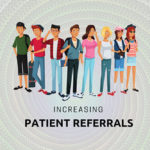Strategic Partnerships – The key to creating ongoing referrals

Ever heard of strategic partnerships or partners? If so, are you aware of how they might positively impact your allied health business?
According to https://bizfluent.com/, “when two companies agree to work together and share physical and/or intellectual resources, they form a strategic partnership. Their relationship is usually formalised by a business contract. This type of agreement aims to help both parties accomplish their goals”. Gen Y entrepreneur and founder of The Entourage, Jack Delosa states “a strategic partnership is a win-win relationship between two complementary businesses”. Delosa believes that “strategic partnerships are the most effective and fastest ways for any start-up or early-stage business to win customers and accelerate growth on a shoestring budget.” Through finding these complementary businesses and leveraging their client base, you will potentially gain access to more targeted prospects.
Strategic partnerships are everywhere in business, and in order for start-ups and small businesses to grow and increase their reach, they are essential. Read on to learn three simple steps you should follow in order to find them, get their attention and then secure them.
Step 1 Find a complementary business
What is a complementary business? When searching for strategic partners, a complementary business is one that you can add value to, whilst they drive you clients from their existing client base. So how do you actually find these complementary businesses? As an allied health provider, you need to consider:
Where do my clients go before they seek my services?
This will obviously depend on which allied health profession you are in but for each profession, your ideal client/patient will almost always visit someone before they get to you. For example:
- It is likely that physiotherapy patients may have first consulted an orthopaedic surgeon and undergone a surgical procedure, have been visiting a remedial massage therapist or have been engaging the services of a personal trainer.
- Personal trainers might find that their ideal clients may first see a physiotherapist for injury advice, be attending a gym or have been recently seen by an orthopaedic surgeon.
- Clients whom eventually seek the services of an acupuncturist may have first be seen by a G.P, physiotherapist or osteopath.
If you are able to identify where your clients go before they come to you, you will find an excellent source of businesses to approach and establish a win-win relationship with.
Where do my clients go after they see me?
Using the same examples as above,
- A physiotherapy client may be referred onto an orthopaedic surgeon, a podiatrist, a pilates instructor or even a dietician.
- Personal training clients may be referred to a physiotherapist, a sports coach, sports physician or kinesiologist.
- Acupuncture clients may seek the services of a Chinese medicine practitioner or return to the G.P who originally referred them.
All it takes is thinking about these two scenarios – where your clients go before and after they see you and approaching these businesses to see if you can establish a working relationship. Whether it means making a practitioner one of your preferred providers and in exchange they include details of your business in their monthly e-newsletter, or running some educational sessions aimed at falls prevention in the elderly at your local GP practice. The ‘win-win’ relationship that you hope to foster is all about developing relationships with those professionals who see the same clientele as you, but for slightly different reasons. Health, fitness and wellness professionals all share similar clients, therefore, all of these professionals have the potential to be strategic partners.
Who targets the same clients I do, but offers a slightly different service or product?
Allied health practitioners share clients with medical professionals. Fitness and wellness businesses share clients with both allied health and medical professionals. Yet, we all offer different services and products. In addition to these businesses, try and look at other professionals who share the same clients but are in completely different industries. For example:
- Perhaps consider talking to an industry production plant, discussing the possibility of providing allied health services to their workforce.
- Offer your allied health services to local sporting teams and events, which will showcase your expertise to a wider audience.
- Expand your own target audience by tapping the audiences of your suppliers, for example, consider partnering up with your sports medical supplier.
As a way of clarifying this for you and your particular profession, sit down with a piece of paper and write down your profession in the middle and then add in all the other services your ideal client might reasonably seek out. Also, write as detailed a list as possible, of ALL the services a client in your demographic, may engage with. These can be services completely unrelated to your service offering but where your ideal client might spend time, money or both.Lastly, don’t forget to look outside the box, and look at your suppliers for a way of expanding your own target audience. You will then have developed a fairly thorough list of potential partners you could reach out to and engage with.
I have a list of potential strategic partners, how do I establish contact?
As an allied health practice owner, it is essential that you maintain a steady stream of new clients coming through your door. Establishing strategic partnerships is an excellent way to continually drive business your way, but how do you actually go about approaching businesses and engaging them?
Social media – heard of it? Get on it!!!! This is a very acceptable way of connecting in today’s business environment and extremely effective. There are many opportunities to contact and engage with complementary businesses through the various social media platforms. Seek out these businesses and get in touch. LinkedIn is the most widely used social platform for B2B so get involved in group discussions, comment on posts and updates and start conversations. Follow
company pages and stay up to date about what your identified complementary businesses are up to. Facebook, Twitter and Instagram are all valuable platforms from which to reach out to businesses and engage, share information and develop mutually beneficial relationships.
Other forms of business networking such as cold calling and attending industry events have merit, though they tend to be much more time-consuming. Cold calling complementary businesses can be disheartening; often the person on the other end of the line is not the one you should be talking to and merely acts as a gatekeeper to those who make the business decisions. If you can manage to set up a meeting with a business’ decision maker, cold-calling can be successful. Attending networking events is also an excellent way of meeting with complementary business owners, with the added bonus of being face-to-face!
Step 2 Develop a compelling reason
When you are considering approaching a strategic partner, think about leading with what you can offer them in a partnership. What value can you add to their business?
The compelling reason could be:
- promoting a prospective partner’s business on your website
- offering a prospective partner’s promotional offer to your email list
- stocking a prospects product line in your practice
- giving a prospective partner exposure to your clientele through writing guest blogs or case studies on your website
If your compelling reason is attractive enough, prospective strategic partners will overlook the fact that you may not be able to immediately monetize their list or offer them profit share. Many businesses are looking for greater reach and small businesses help them find this.
Step 3 Develop a compelling offer
After identifying potential strategic partners and developing a compelling reason for them to partner with you, you must create a compelling offer. Compelling offers come in a variety of shapes and sizes. The golden rule to keep in mind is that your compelling offer or ‘lead magnet’ should be an asset that adds value to your audience. Rather than trying to sell your product or services straight up, you need to offer your audience something of value that will resolve a problem they have. By giving something of value you not only help address your audience’s pain points but you start building a reputation as an authority in your field. When your audience is ready to purchase a product or engage a service, your business will be front of mind. As allied health practitioners and practice owners, things that
spring to mind immediately might be:
- an e-book detailing evidence-based rehabilitation programs patients are able to follow independently at home
- tip sheet on correct lifting techniques
- checklist of ergonomic workstation set-up
- video demonstrating warm-up and cool-down exercises for injury prevention
If you are unsure of what to include in your compelling offer, actively find out what your audience want to know. What are their challenges or pain points? What one thing could you help solve that would enable your audience to reach their goals? Once you know this, you will be able to generate a valuable lead magnet and use it to educate your audience and solve their problems. Your lead magnets will help you build influence, trust and authority in your profession. This will lead to strategic partner satisfaction as they will be viewed in a positive light when they are promoting someone of influence and integrity.
In conclusion, strategic partnerships are a moving vehicle every start-up or early stage business needs to get on. They allow a small business to leverage off larger ones, whilst still engaging a partner in a win-win relationship. Businesses are all different; find one that complements your allied health practice, develop a compelling reason for them to partner with you and create an amazing offer that will grant you access to a more targeted audience that you can then go on to educate and wow!
References
- https://bizfluent.com/about-6511465-meaning-strategic-partner-.html
- https://www.the-entourage.com/blog/the-1-secret-to-gaining-access-to-new-customers-on-a-shoestring-budget/
- Jack Delosa, 2014. UnProfessional: How a 26-year-old University Dropout Became a Self-made Millionaire. 1 Edition. Wrightbooks. Pg 31
- Jonha Richman. 2016. 4 Ways You Can Secure Partnerships for Your Startup. [ONLINE] Available at:https://www.entrepreneur.com/article/249238. [Accessed 21 June 2016].
- Adam Toren. 2016. 5 Quotes About Leverage to Help You Push Your Business Forward. [ONLINE] Available at: https://www.entrepreneur.com/article/237180. [Accessed 21 June 2016].




